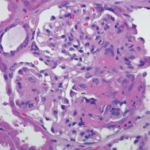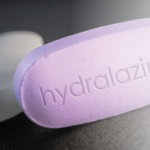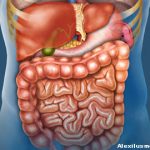In managing IBD, it is vital to work closely with other specialists to determine the true etiology of symptoms. Gastroenterologists, in particular, play an important role, ensuring bowel disease activity is suppressed prior to considering overlap syndromes.
One month later, he developed daily fevers and hemoptysis, again requiring hospital admission. A pulmonologist was consulted, and bronchoscopy revealed extensive ulcerative tracheobronchitis. At the same time, a colonoscopy demonstrated active inflammation in the rectum and sigmoid. His pulmonary presentation was, therefore, deemed to be yet another rare extra-intestinal manifestation of his UC and part of his current flare. For management, he was given high-dose steroids, ustekinumab and mesalamine. This therapy stabilized his symptoms, and he was discharged in May 2018 with a tapering dose of prednisone.
In July 2018, the patient passed away due to complications from his liver transplant.
Various specialists from multiple disciplines had been involved in managing his disease. Despite several sinus, gum, colonic and skin biopsies, no histological evidence of vasculitis was ever revealed. Moreover, colonic biopsies and visual inspection on colonoscopy were in keeping with active UC. Therefore, the consensus was that his presentation was in keeping with IBD and rare extra-intestinal manifestations rather than a case of GPA-IBD overlap.
Discussion
The diagnosis of true GPA-IBD overlap is challenging given the rarity of this condition. To the best of our knowledge, fewer than 35 cases have been reported in the literature.3-7 In general, patients with GPA-IBD overlap are women.3 Although vasculitis can precede or concurrently present with IBD, most patients tend to develop bowel symptoms first.3-7 The vasculitic manifestations in GPA-IBD overlap are variable, and reports of renal, neurological, otolaryngologic and cutaneous symptoms have been made.3-7 In addition, almost all patients invariably have some degree of pulmonary involvement, although the most common symptoms are non-specific, such as cough, dyspnea and fever.5 Further, most previous reported cases of GPA-IBD overlap have involved positive ANCA serology and demonstrated histological confirmation of both IBD and vasculitis.3-7
The diagnosis of GPA-IBD overlap is further complicated because certain extra-intestinal manifestations of IBD can mimic GPA, as seen in our case. Extra-intestinal manifestations occur in up to 30% of IBD patients and are generally more common in UC than in Crohn’s disease.8,9 Up to 15% of IBD patients develop cutaneous manifestations, such as pyoderma gangrenosum.1
Pyoderma gangrenosum is classically described as deep, ulcerating lesions with well-defined violaceous or blue borders; however, this entity has 10 distinct variants that have slightly different gross and microscopic features.1,10 Neutrophilic folliculitis, which was diagnosed in our patient, is one form of pustular pyoderma gangrenosum and most typically presents as large, discreet, painful pustules.1 Treatment options for pyoderma gangrenosum include azathioprine, cyclosporine, cyclophosphamide, intralesional steroid injections and hyperbaric oxygen.8
Another rare extra-intestinal manifestation seen in our patient was pyostomatitis vegetans. This gingival disorder, which is highly specific for IBD, is characterized by pustules and erosions within the oral mucosa.2 Pyostomatitis vegetans has also been reported in patients with relatively quiescent bowel symptoms, similar to our case.11 In contrast, strawberry gingivitis, which is associated with GPA, is due to gum hypertrophy and petechial hemorrhage.2
On visual inspection, these distinct conditions can appear similar; therefore, biopsy and clinical context are required to differentiate between pyostomatitis vegetans and strawberry gingivitis.
In terms of management for pyostomatitis vegetans occurring without associated gastrointestinal flare, topical corticosteroids or topical tacrolimus can be used.12,13 However, this symptom tends to be recalcitrant to treatment, and most cases will require systemic steroids.12 Other pharmaceutical options include dapsone, cyclosporin, azathioprine and sulfasalazine.12
Pulmonary involvement in IBD was first described by Kraft et al. in 1976.14 More recently, Storch et al. summarized more than 400 cases of patients with IBD and respiratory disease.15 They categorized these pulmonary manifestations within groups, such as airway disease, interstitial disease, overlapping syndromes and pulmonary vasculitis, similar to GPA.
Most commonly, patients present with non-specific symptoms, such as cough and dyspnea.10 A large portion of patients also have subclinical lung disease, based on studies using screening with pulmonary function tests.16 However, tracheal involvement in IBD, as seen in our patient, remains rare, with only a few other cases reported in the literature.17-19 Tracheal manifestations of IBD can range from asymptomatic tracheal thickening incidentally found on imaging to life-threatening disease. In a majority of circumstances, patients are often unwell with symptoms of hemoptysis, dyspnea, dysphonia and respiratory distress.10 GPA is, interestingly, often part of the differential diagnosis given the dramatic and similar clinical presentation. Inflammation within the trachea can be severe and lead to complications, such as tracheal stenosis, obstruction, rupture and death.10 Many patients with IBD and tracheal involvement require high doses of steroids, bronchodilators and admission to an intensive care unit for airway protection.10



